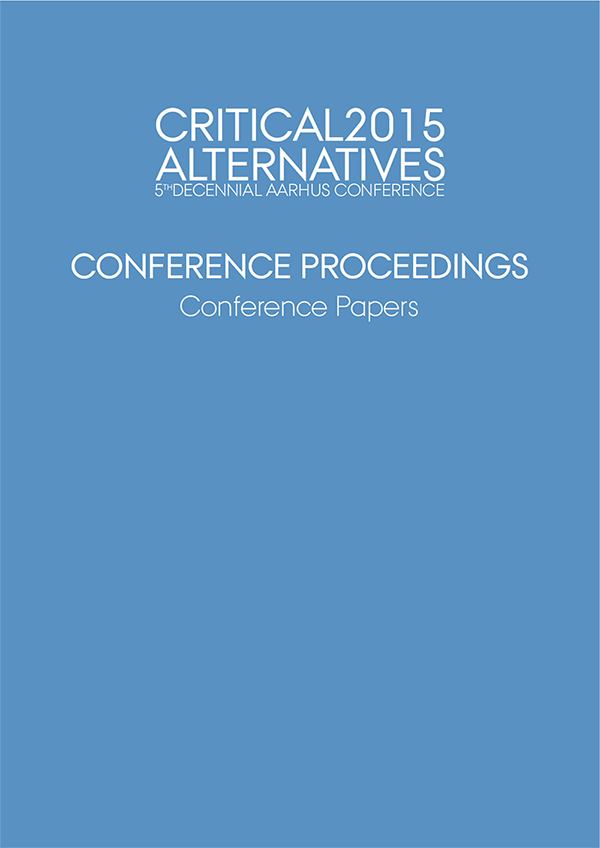Concordance: A Critical Participatory Alternative in Healthcare IT
DOI:
https://doi.org/10.7146/aahcc.v1i1.21315Nøgleord:
Concordance, Critical Alternative, Participatory Design, Healthcare, Ongoing design, InfrastructuringResumé
The healthcare sector is undergoing large changes in which technology is given a more active role in both in-clinic and out-of-clinic care. Authoritative healthcare models such as compliance and adherence which relies on asymmetric patient-doctor relationships are being challenged as society, patient roles and care contexts transforms, for example when care activities move into non-clinical contexts. Concordance is an alternative model proposed by the medical field that favours an equal and collaborative patient-doctor relationship in the negotiation of care. Similarly, HCI researchers have applied diverse models of engagement in IT design ranging from authoritative models (e.g. perceiving people as human factors to design for) to more democratic design processes (e.g. Participatory Design). IT design has also been crafted as on-going processes that are integrated parts of everyday use. Based on the best practice of participation from the medical and the HCI fields, we identify critical alternatives for healthcare design. These alternatives highlight opportunities with ongoing design processes in which the design of care regimens and care IT are perceived as one process.
Referencer
Andersen, T., Bjørn, P., Kensing, F., et al. Designing for collaborative interpretation in telemonitoring: Re- introducing patients as diagnostic agents. International Journal of Medical Informatics, 2011, 80(8):e112-e126.
Bagalkot, N. L., Grönvall, E. and Sokoler, T., Concordance: design ideal for facilitating situated negotiations in out-of-clinic healthcare, In Proc. EA CHI '14, ACM Press(2014), 855-864.
Bannon, L., From human factors to human actors: the role of psychology and human-computer interaction studies in system design, In Design at work: cooperative design of computer systems, Lawrence Erlbaum Associates, Inc., Hillsdale, New Jersey, USA, 1991.
Dantec, C. L. and DiSalvo, C. Infrastructuring and the Formation of Publics in Participatory Design. Social Studies of Science, 2013, 43(2): 241-264.
Ehn, P., Participation in design things, In Proc. PDC 2008, ACM Press(2008), 92-101.
Fitzpatrick, G. and Ellingsen, G. A Review of 25 Years of CSCW Research in Healthcare: Contributions, Challenges and Future Agendas. Computer Supported Cooperative Work (CSCW), 2012, 22(4-6):609-665.
Grönvall, E. and Kyng, M. On participatory design of home-based healthcare. Cognition, Technology & Work, 2013, 15(4):389-401.
Grönvall, E. and Verdezoto, N., Beyond Self- Monitoring: Understanding Non-functional Aspects of Home-based Healthcare Technology, In Proc. UbiComp 2013, ACM Press(2013), 587-596.
Horne, R., Weinman, J., Barber, N., et al. Concordance, adherence and compliance in medicine taking. London: NCCSDO, 2005.
Iversen, O. S., Kanstrup, A. M. and Petersen, M. G., A visit to the 'new Utopia': revitalizing democracy, emancipation and quality in co-operative design, In Proc. NordiCHI 2004, ACM Press(2004), 171-179.
Kaptelinin, V. and Bannon, L. J. Interaction Design Beyond the Product: Creating Technology-Enhanced Activity Spaces. Human–Computer Interaction, 2011, 27(3):277-309.
Kusk, K., Nielsen, D. B., Thylstrup, T., et al., Feasibility of using a lightweight context-aware system for facilitating reliable home blood pressure self- measurements, In Proc. PervasiveHealth 2013, IEEE (2013), 236-239.
Moore, K. N. Compliance or Collaboration? the Meaning for the Patient. Nursing Ethics, 1995, 2(1):71-77
Oliveira, R. d., Cherubini, M. and Oliver, N., MoviPill: improving medication compliance for elders using a mobile persuasive social game, In Proc. UBICOMP 2010, ACM Press(2010), 251-260.
Segal, J. “Compliance” to “Concordance”: A Critical View. Journal of Medical Humanities, 2007, 28(2):81- 96.
Seravalli, A., Infrastructuring for opening production, from participatory design to participatory making?, In Proc. PDC 2012, ACM Press(2012), 53-56.
Siek, K., Khan, D., Ross, S., et al. Designing a Personal Health Application for Older Adults to Manage Medications: A Comprehensive Case Study. Journal of Medical Systems, 2011, 35(5):1099-1121.
Simonsen, J. and Hertzum, M., A Regional PD Strategy for EPR Systems: Evidence-Based IT Development, In Proc. PDC 2006-Vol II, 2006, 125-228.
Spencer, M., Dineen, R. and Phillips, A., Co-producing services – Co-creating health, NHS WALES, 2013.
Storni, C. Multiple Forms of Appropriation in Self-
Monitoring Technology: Reflections on the Role of Evaluation in Future Self-Care. International Journal of Human-Computer Interaction, 2010, 26(5):537-561.
The health fundation, Co-creating Health, from: http://www.health.org.uk/programmes/co-creating- health, 2008.
Uzor, S., Baillie, L. and Skelton, D., Senior designers: empowering seniors to design enjoyable falls rehabilitation tools, In Proc. CHI 2012, ACM Press(2012), 1179-1188.
Vitality - GlowCaps, from: www.vitality.net, 2012. 24. Aarhus, R., Ballegaard, S. and Hansen, T., The eDiary:
Bridging home and hospital through healthcare technology, In Proc ECSCW 2009, Springer(2009), 63- 83.
The columns on the last page should be of approximately equal length. Remove these two lines from your final version.




